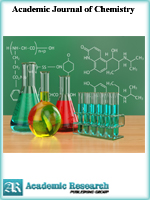Academic Journal of Chemistry
Online ISSN: 2519-7045
Print ISSN: 2521-0211
Print ISSN: 2521-0211
Quarterly Published (4 Issues Per Year)

Archives
Volume 5 Number 1 January 2020
Synthesis, Characterization and DNA Binding Studies of Zn(II)/Cu(II) Complexes with 2,2`-Diphenyl Acetic Acid/2-(4-Hydroxyphenyl)Acetic Acid Ligand Precursors and Nitrogen Bases
Authors: Muhammad Naeem ; Saqib Ali ; Saira Shahzadi ; Kaleem Ullah ; Shabbir Hussain ; Sadaf Ramzan ; Shagufta Kamal
Pages: 1-9
DOI: doi.org/10.32861/ajc.51.1.9
Abstract
The hydrated complexes 1, 3, 7 and 8 with the general formula (RCOO)2M.xH2O (where M = Zn & x = 6; M = Cu & x = 5,6) were synthesized by the reaction of sodium salt of 2,2`-diphenyl acetic acid or 2-(4-hydroxyphenyl)acetic acid (RCOONa) with Zn(NO3)2.6H2O or CuSO4.5H2O in an aqueous medium. The addition of methanolic solution of either bipyridine (bpy) or 1,10-phenanthroline (phen) to an aqueous suspension of 1, 3, 7 and 8 (produced in situ) result in the formation of mixed ligand products with the general formulae (RCOO)2M(bpy).xH2O (2, 4, 9 and 10) and (RCOO)2M(phen).xH2O (5 and 6). The complexes were characterized by microanalysis, FTIR and NMR (1H and 13C) spectroscopic techniques. The FTIR data suggested a bidentate coordination mode of the carboxylate ligand and complexes exhibited four/six-coordinated geometry in the solid state. The spectroscopic data also revealed the presence of coordinated water molecules in all complexes. 1H and 13C NMR data demonstrated the coordination between ligand and the metal in complex 1. The complexes were tested for their binding with salmon sperm DNA (SS-DNA). The DNA binding potential of the complexes owed to the presence of zinc metal and the nature of the incorporated ligand. The complexes showed a significant hypochromic effect and an intercalating mode of binding with SS-DNA. The complexes were screened against various bacterial and fungal strains to check their biological activity. All the complexes showed significant antibacterial activity but none of complex exhibit antifungal activity.



